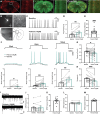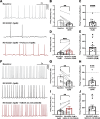Psychedelic compounds directly excite 5-HT2A layer V medial prefrontal cortex neurons through 5-HT2A Gq activation
- PMID: 41052972
- PMCID: PMC12501219
- DOI: 10.1038/s41398-025-03611-0
Psychedelic compounds directly excite 5-HT2A layer V medial prefrontal cortex neurons through 5-HT2A Gq activation
Abstract
Psilocybin, and its active metabolite psilocin, have seen renewed interest due to studies suggesting potential therapeutic utility. 5-Hydroxytryptamine2A receptors (5-HT2ARs) are primary mediators of the psychoactive effects of psychedelics in animals and humans, but the underlying neurobiological mechanisms remain poorly understood. Functional magnetic resonance imaging identified significant psilocin-induced increases in medial prefrontal cortex (mPFC) activity, a site of enriched 5-HT2AR expression. We identified a population of 5-HT2AR neurons in the prelimbic/anterior cingulate mPFC. Psilocin and the 5-HT2AR-selective compound 25-CN-NBOH increased excitability, and stimulated firing across a range of current injections in these neurons that was both 5-HT2AR and Gαq dependent. Similar effects were observed with a novel, non-hallucinogenic psychedelic compound. These findings provide valuable insight into the specific role of 5-HT2AR-containing neurons in psychedelic-associated plasticity in mPFC regions that are likely implicated in the clinical effects of psychedelics and further identify membrane-bound 5-HT2ARs and subsequent intracellular Gαq signaling as therapeutic targets.
© 2025. The Author(s).
Conflict of interest statement
Competing interests: The authors declare no competing interests.
Figures






References
-
- Slocum ST, Diberto JF, Roth BL. Molecular insights into psychedelic drug action. J Neurochemistry. 2021. 10.1111/jnc.15540 - PubMed
-
- Nutt D, Erritzoe D, Carhart-Harris R. Psychedelic psychiatry’s brave new world. Cell. 2020;181:24–28. 10.1016/j.cell.2020.03.020 - PubMed
-
- Ross S, Bossis A, Guss J, Agin-Liebes G, Malone T, Cohen B, et al. Rapid and sustained symptom reduction following psilocybin treatment for anxiety and depression in patients with life-threatening cancer: a randomized controlled trial. J Psychopharmacol. 2016;30:1165–80. 10.1177/0269881116675512 - PMC - PubMed
MeSH terms
Substances
Grants and funding
- AA011605/U.S. Department of Health & Human Services | NIH | National Institute on Alcohol Abuse and Alcoholism (NIAAA)
- P60 AA011605/AA/NIAAA NIH HHS/United States
- AA026858/U.S. Department of Health & Human Services | NIH | National Institute on Alcohol Abuse and Alcoholism (NIAAA)
- MH112205/U.S. Department of Health & Human Services | NIH | National Institute of Mental Health (NIMH)
- R01 MH112205/MH/NIMH NIH HHS/United States
- P50 AA011605/AA/NIAAA NIH HHS/United States
- HR00112020029/United States Department of Defense | Defense Advanced Research Projects Agency (DARPA)
- NARSAD Young Investigator/Brain and Behavior Research Foundation (Brain & Behavior Research Foundation)
- R01 AA026858/AA/NIAAA NIH HHS/United States
- R37 DA045657/DA/NIDA NIH HHS/United States
- DA045657/U.S. Department of Health & Human Services | NIH | National Institute on Drug Abuse (NIDA)
LinkOut - more resources
Full Text Sources

